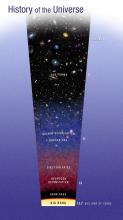Listen to today's episode of StarDate on the web the same day it airs in high-quality streaming audio without any extra ads or announcements. Choose a $8 one-month pass, or listen every day for a year for just $30.
You are here
Golden Stars
Gold, silver, and platinum have something in common besides their beauty. All of them are “ashes” from the destruction of stars. Every gram of these elements — not only on Earth, but throughout the universe — was forged in stellar explosions or collisions.
Hydrogen and helium — the lightest elements — were created in the Big Bang. Most other elements were forged in the hearts of stars. But almost all of the heaviest elements — everything beyond iron — were created in stellar deaths.
A lot of gold, silver, and platinum were formed in the collisions of neutron stars — the tiny, ultra-dense corpses of once-mighty stars. Such collisions blast debris into space and heat it to tens of millions of degrees. At those temperatures, neutrons stick to the nuclei of heavy elements, making even heavier ones.
Astronomers saw that process at work in 2017. They watched as colliding neutron stars created enough silver to make 50 planets as heavy as Earth, enough gold to make a hundred Earths, and enough platinum to make five hundred.
But neutron star collisions are rare, so they may not account for all of these precious metals observed in the universe. So some of them could be made in the death throes of massive stars — if they collapse to form black holes, for example.
Regardless of the details, though, one thing is certain: It takes the death of a star to forge some of the rarest and most beautiful elements on Earth.
Script by Damond Benningfield




